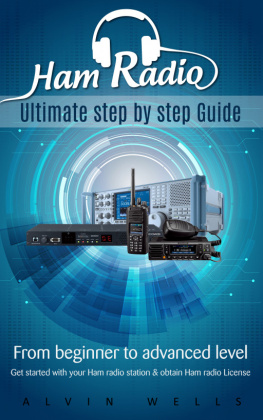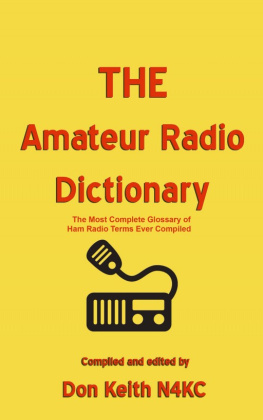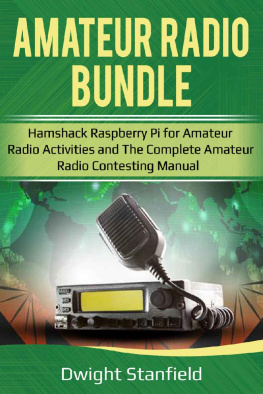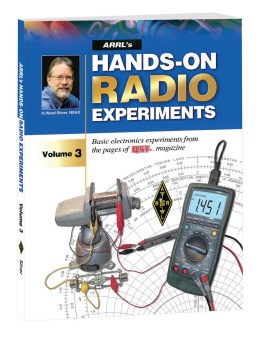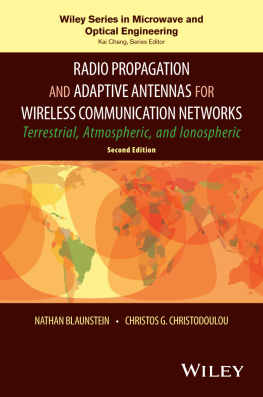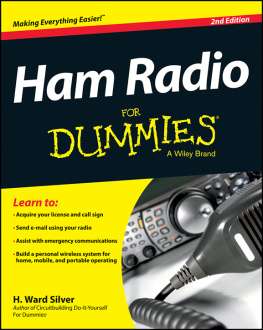Copyright 2015 by The American Radio Relay League, Inc.
Copyright secured under the Pan-American Convention
All rights reserved. No part of this work may be reproduced in any form except by written permission of the publisher. All rights of translation are reserved.
Printed in the USA
Quedan reservados todos los derechos
ISBN: 978-1-62595-027-7
First Edition
We strive to produce books without errors. Sometimes mistakes do occur, however. When we become aware of problems in our books (other than obvious typographical errors), we post corrections on the ARRL website. If you think you have found an error, please check .
eBooks created by www.ebookconversion.com
This eBook was posted by AlenMiler on AvaxHome!
Many New eBooks in my Blog: https://avxhm.se/blogs/AlenMiler
Mirror: http://avxhome.in/blogs/AlenMiler
Contents
Foreword
One of the most fascinating and rewarding activities in Amateur Radio is studying the often baffling and sometimes frustrating phenomenon of radio propagation. Actually, radio propagation is not just one phenomenon, but rather many phenomena, all of which add up to an intriguing journey of radio waves from transmitter to receiver through the voids of space.
Unlike sound, radio waves travel without the need for a medium, a truly amazing property that has intrigued physicists and philosophers for over a century. Understanding how radio waves interact with their environment is an important factor in achieving effective Amateur Radio communications. Amateur frequencies span the entire electromagnetic spectrum, at least in chunks, and each portion of the radio spectrum has unique advantages and potential pitfalls.
A dedicated and skillful radio amateur may take great pains to assure that the stations transmitter, receiver, and antennas are functioning at their optimum potential, yet once a radio wave leaves the antenna, it is at the mercy of the ether.
Because we have no control over the ether, our only option is to understand what it is doing and accommodate its often fickle behavior. This can be a hams greatest joy or a source of great frustration. And yet, as unpredictable as propagation can be at times, there is a great deal that we do know. And that is what this book is about.
In Propagation and Radio Science, author Eric Nichols, KL7AJ, puts radio propagation front and center. In his lively and engaging writing style, Eric explains many of the phenomena we observe on the amateur bands and encourages us to learn more and experiment using readily available tools. We hope you will make use of the wealth of information found here.
David Sumner, K1ZZ
Chief Executive Officer
Newington, Connecticut
March 2015
Preface
The Invisible Journey
For about a century, radio amateurs have been launching radio signals into the ether, using equipment ranging from the primitive to the elegant. Technology and technique has improved enormously over the years, greatly increasing the reliability and effectiveness of this thing we call radio. However, the one thing radio amateurs have no control over is propagation, the unseen path between transmitter and receiver that every radio signal must take, whether across the street or to the Moon and back. There are countless varieties of ways a radio signal can get from Point A to Point B, a path that can be fascinating, frustrating, mystifying, and mesmerizing.
Theres a lot we know about radio propagation, but theres a lot more we dont know. It is a field still wide open to exploration and experimentation. And for radio amateurs, the ether is still absolutely free.
Many excellent Amateur Radio books include valuable sections on radio propagation, but the subject is so vast and wide that a chapter or two simply cannot do justice to this most fascinating aspect of Amateur Radio. It is appropriate to have a book dedicated to nothing but radio propagation. Propagation and Radio Science is just that book; in this comprehensive tome we explore radio propagation from dc to daylight, from the trivial to the truly bizarre. We trust you will find it a worthy companion to the venerable ARRL Handbook and ARRL Antenna Book.
In Propagation and Radio Science, the most daunting mathematics is safely tucked away, while the free-flowing narrative presents the story of radio propagation in simple, intuitive, and graphic terms. This method will allow the reader to understand this somewhat complex topic on different levels, according to his or her experience and needs, either practical application, or a complete theoretical exploration. In the final chapters, we will delve into the still-unknown nooks and crannies of radio propagation and suggest areas of exploration for the curious radio amateur.
Special thanks to Carl Leutzelschwab, K9LA, for reviewing this work.
Eric P. Nichols, KL7AJ
North Pole Alaska, March 2015
Introduction
A Wide World for the Technician Class Amateur
Theres a common misconception that Technician class Amateur Radio operators dont have high frequency (HF) privileges, and must wait until they upgrade to General or Amateur Extra status to take advantage of worldwide shortwave communications. This is not true. As a Technician licensee, you have inherited all the HF privileges of the former Novice class license, which affords privileges on 80, 40, 15, and 10 meters. This is in addition to the more commonly advertised VHF and UHF privileges you already know about.
Back in the day (before the codeless Technician boom in the early 1990s), just about every new radio amateur started out with a Novice license. When the Novice license was created in 1951, Novices had some HF CW privileges, along with CW and voice on 2 meters. The license was good for two years and not renewable. In later years, the 2 meter privileges went away and some 10 meter voice and data privileges were added and the Novice license was renewable with the same terms as the other licenses.
While restricted to CW operation (and later a small segment on 10 meter RTTY, data and SSB) and relatively low power, most old timers worked the world on the Novice bands. By the time they upgraded to one of the more advanced licenses, most hams had a good feel for HF propagation. In fact, long before obtaining their Novice licenses, most hams had some experience tuning around on the shortwave bands with a general coverage receiver (SWLing) and had at least an idea of what to expect when it came to long distance radio behavior.
This is no longer the case. A lot of recent Amateur Radio training material geared toward the new Technician license mentions HF as a mere footnote, if at all, while concentrating on local VHF and UHF operation. Most new hams have little or no idea what HF propagation is all about; a fairly large proportion of them have never operated a shortwave radio, even briefly. This is a shame, because much of the exciting stuff happening in Amateur Radio is on the HF bands.
Well take some considerable time here to talk about what you can do on HF with only a Technician license, so you have no excuse not to explore the core of Amateur Radio.
The Code is the Mode
Except for 10 meters, where a portion of the band is allocated to voice (phone) privileges, your HF Technician privileges allow for CW (Morse code) only. While there is no prohibition against using a computer to generate and receive CW, there is no reason not to learn Morse code (more officially known as the International Radiotelegraph Code). Ironically enough, now that Morse code is not required for any class of license, there is actually more high quality CW on the air than ever before. This is because a lot of hams learn CW because they want to, not because they have to!


